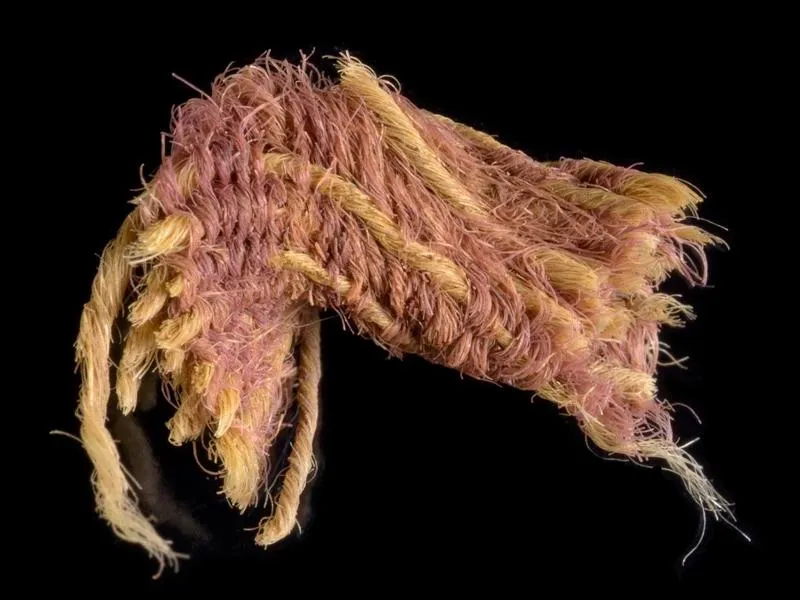‘Royal Purple’ Fabric Dated to Time of Biblical King David Found in Israel
Derived from the bodies of snails, the dye used on the wool fibers was extremely valuable in the ancient world
:focal(816x480:817x481)/https://tf-cmsv2-smithsonianmag-media.s3.amazonaws.com/filer/39/10/39105b48-2fc6-42b8-b073-ae55a970992d/purple_wool.jpg)
Biblical stories describe prominent figures clothed in garments of purple—a color long associated with royalty. Now, reports BBC News, archaeologists in Israel have discovered fragments of purple fabric dated to around the time of the purported reigns of King David and Solomon.
The team discovered the material in the Timna Valley, at a site known as Slaves’ Hill. Carbon dating places its creation around 1000 B.C. Religious lore suggests that David’s reign spanned roughly 1010 to 970 B.C., while Solomon’s lasted from 970 to 931 B.C.
A collaboration between the Israel Antiquities Authority (IAA), Tel Aviv University and Bar Ilan University, the research is newly outlined in the journal PLOS One.
“The color immediately attracted our attention, but we found it hard to believe that we had found true purple from such an ancient period,” says study co-author Erez Ben-Yosef, an archaeologist at Tel Aviv University, in a statement.
Derived from the bodies of snails, the dye used on the wool fibers was extremely valuable in the ancient world. Previous excavations had found the color on mollusk shells and pottery fragments, but not on fabrics.
“In antiquity, purple attire was associated with the nobility, with priests, and of course with royalty,” says lead author Naama Sukenik, a curator of organic materials at the IAA, in the statement. “The gorgeous shade of the purple, the fact that it does not fade, and the difficulty in producing the dye, which is found in minute quantities in the body of mollusks, all made it the most highly valued of the dyes, which often cost more than gold.”
The researchers’ analysis of the purple dye revealed that it contains unique molecules found only in a gland in the bodies of three mollusk species. Compared with other plant-based fabric dyes of the time, the animal-based dye is much more difficult to extract.
Creating the “true purple” color involved a chemical process that took several days, according to the paper. The labor and complex knowledge required to produce purple cloth helped make it an indicator of high social status.
Timna, the site of copper mines also dated to around 1000 B.C., has excellent conditions for the preservation of ancient materials. Per the Jewish News Syndicate, the site was part of the biblical kingdom of Edom, which bordered Israel to the south. In the statement, Ben-Yosef says that the find testifies to a sophisticated and socially stratified society in Edom, despite the fact that its people were nomadic.
“When we think of nomads, it is difficult for us to free ourselves from comparisons with contemporary Bedouins, and we therefore find it hard to imagine kings without magnificent stone palaces and walled cities,” he explains. “Yet in certain circumstances, nomads can also create a complex socio-political structure, one that the biblical writers could identify as a kingdom.”
Ben-Yosef suggests that the findings have implications for archaeologists’ ongoing search for physical evidence of David’s reign in Israel. As Ruth Margalit wrote for the New Yorker last year, the quest for the ancient Israeli kingdom known as the United Monarchy is important to many Jews, Christians and Muslims. The reigns of David and Solomon are often depicted as Israel’s golden age, and the periods have connections to the stories of Jesus and Muhammad. But researchers have found little archaeological evidence related to biblical depictions of that time. (Last November, researchers in the Golan Heights, a 500-square-mile plateau claimed by both Israel and Syria, discovered the ruins of a fort also dated to David’s reign, as Amanda Borschel-Dan reported for the Times of Israel.)
“We know that the Tribes of Israel were originally nomadic and that the process of settlement was gradual and prolonged,” says Ben-Yosef in the statement. “Archaeologists are looking for King David's palace. However, David may not have expressed his wealth in splendid buildings, but with objects more suited to a nomadic heritage such as textiles and artifacts.”
/https://tf-cmsv2-smithsonianmag-media.s3.amazonaws.com/accounts/headshot/Livia_lg_thumbnail.png)
/https://tf-cmsv2-smithsonianmag-media.s3.amazonaws.com/filer/a7/8c/a78cb069-d93a-4c16-8726-2a7cb9fe3408/snailsjpg.jpg)

/https://tf-cmsv2-smithsonianmag-media.s3.amazonaws.com/accounts/headshot/Livia_lg_thumbnail.png)